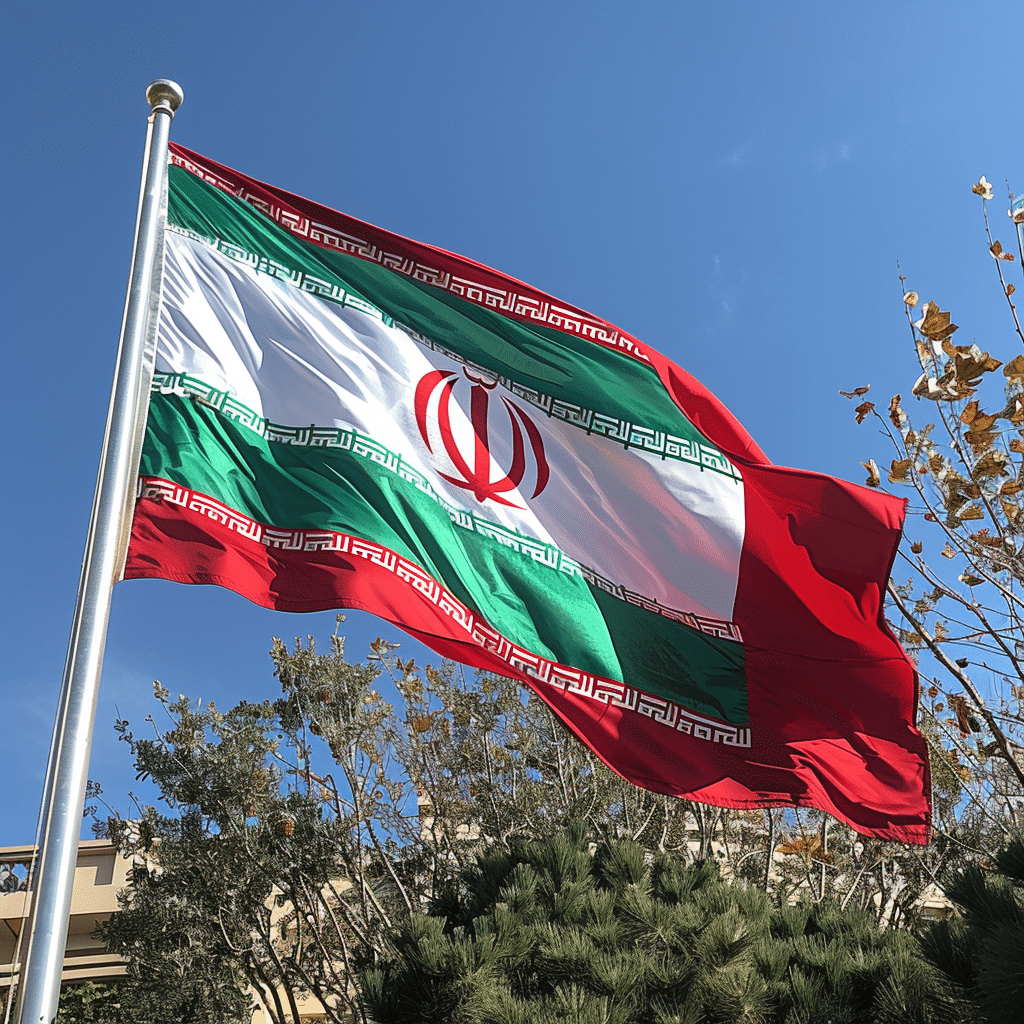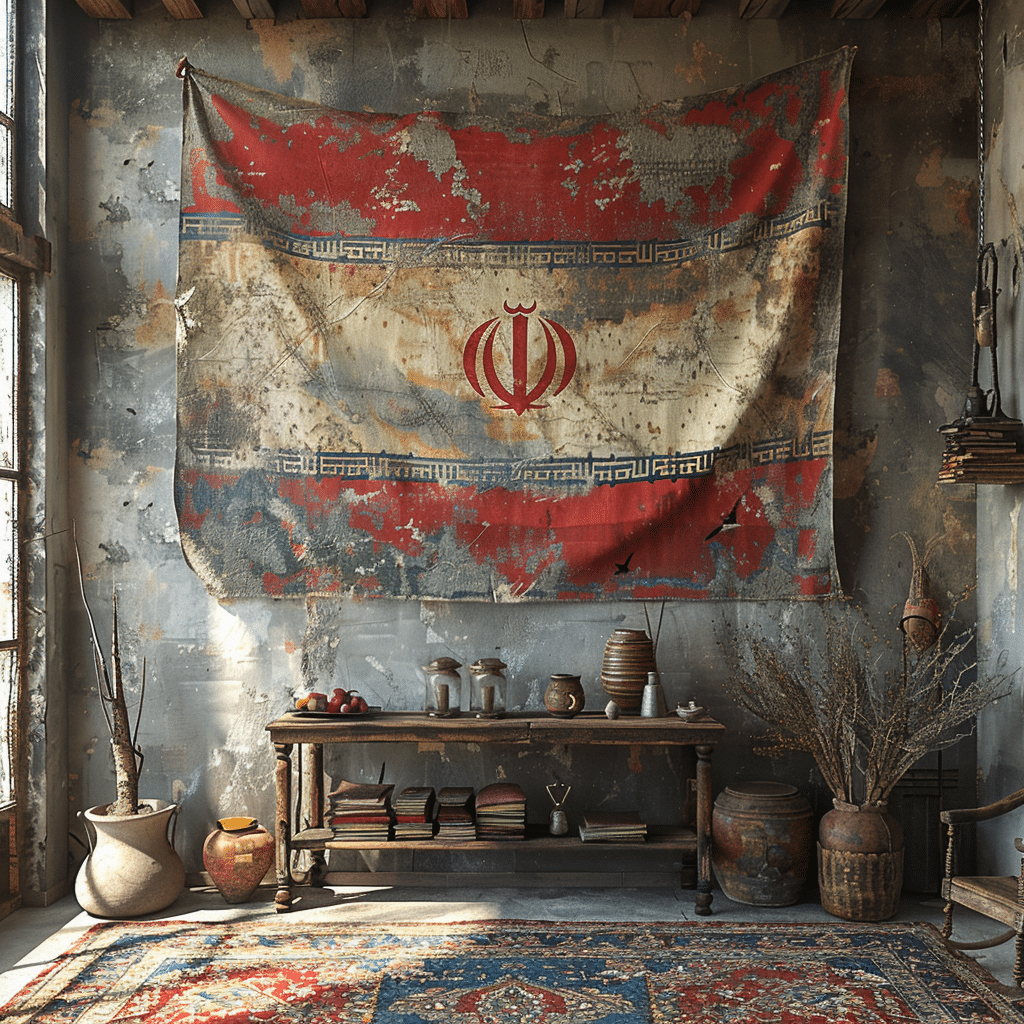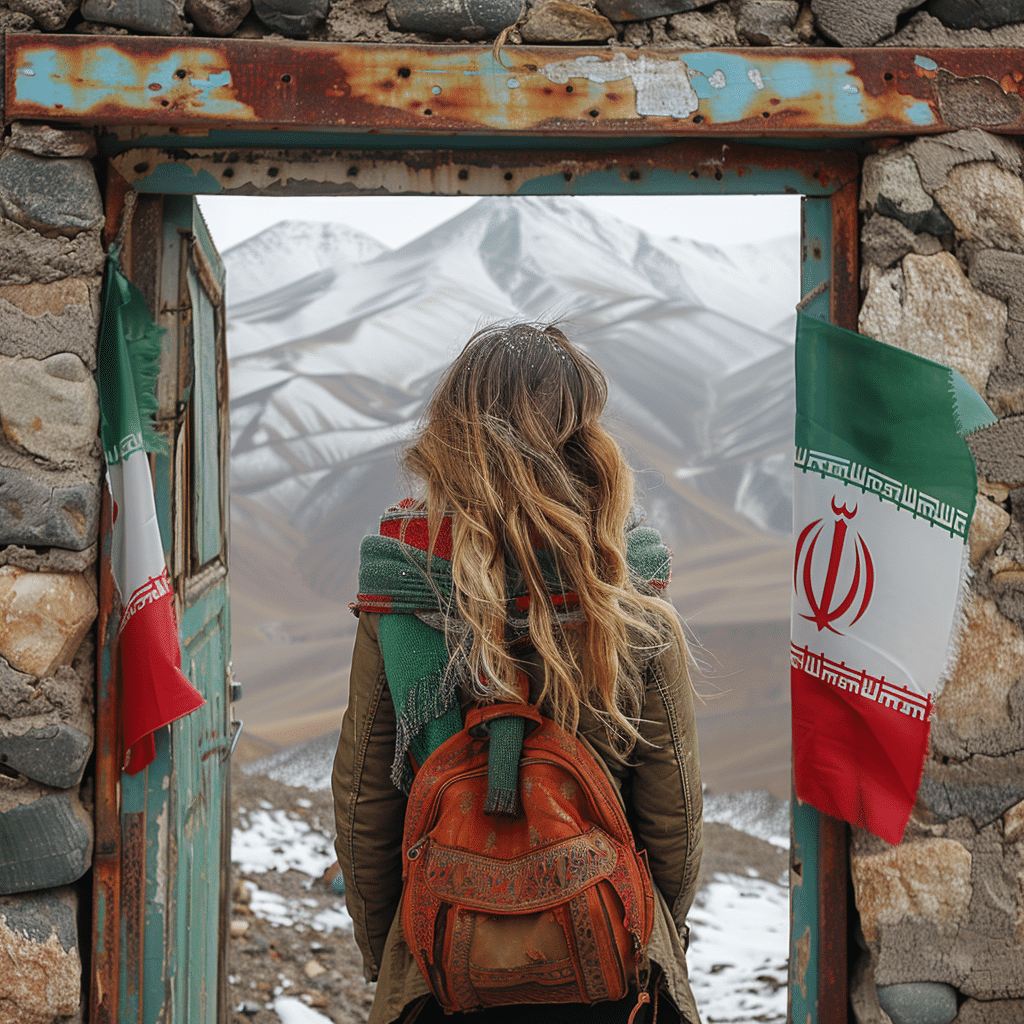When it’s hoisted high, fluttering with a rhythm that matches the heartbeat of a nation, the Iranian flag is a spectacle of collective identity and pride. This isn’t your run-of-the-mill banner; it’s a profound emblem teeming with the spirit of the Iranian ethos. With its distinctive trio of colors—green, white, and red—and the emblematic ‘Allah’ in the middle snuggled within the embrace of the ‘Takbir’ written in assertive Kufic script, the Iranian flag weaves a tale that’s as rich as Iran’s ancient tapestry.
Unfolding the Historical Layers Behind the Iranian Flag
Let’s take a stroll down history lane, shall we? The Iranian flag is a storied book, with each hue and emblem echoing a chapter of Iran’s illustrious and turbulent past. For four centuries, the lion and the sun danced a potent political and cultural tango across the flag—a symbol of sovereignty, associated with royal patronage as far back as the 12th century, until the Islamic Republic ushered in a new era with the current flag in 1980.
And the star of the flag, the emblem, where the word “Allah” is wrapped up by the geometrically stylized form of the Islamic phrase ‘Allahu Akbar’ (God is the greatest) in a quadruplicity of crescents and a sword, symbolizes the values of the Islamic Republic and independence.

Iran Flag as a Political and Cultural Statement
Over the years, the Iranian flag has witnessed the ebb and flow of political tides, from uproarious crowds in the streets of Tehran demanding change to the pivotal moments where Iran makes its stance known on international platforms. It’s also a cultural bookmark that denotes the ethos of an era, still basking in the light of those cultures that reinforced the lion and sun motif—where Islamic, Turkic, and Mongol traditions interlaced the symbol of the lion with undeniable authority.
| Attribute | Description |
|---|---|
| Current Name | National flag of the Islamic Republic of Iran |
| Persian Name | پرچم ایران |
| Alternative Name | Tricolor (پرچم سهرنگ ایران) |
| Date of Adoption | July 29, 1980 |
| Proportions | 4:7 |
| Design | A horizontal tricolor of green, white, and red bands with the national emblem and takbir |
| National Emblem | Symbol “Allah” in red, centered on the white band |
| Takbir Inscription | Repeated 22 times along the bottom of the green band and the top of the red band |
| Historic Symbol | Lion and Sun (used for four centuries, abolished in 1980) |
| Symbol Significance | Lion and Sun: represents power, royalty, and the astrological sign of the sun in Leo |
| Colors | Green (top), White (middle), Red (bottom) |
| Green Symbolism | Represents growth, happiness, unity, nature, vitality, and the Persian language |
| White Symbolism | Symbolizes freedom, peace, and cleanliness |
| Red Symbolism | Stands for bravery, fire, life, love, warmth, and sophistication |
| Previous Symbol Adoption | The Lion and Sun was an official symbol from the 12th century |
| Cultural Influence | Islamic, Turkic, and Mongol traditions influenced the Lion and Sun motif |
| Historical Reference | “Persia is known to-day as the Land of the Lion and Sun” – A.Jackson, p.56 |
| Penalization for Old Flag | Use of the Lion and Sun flag was made punishable after the 1979 Islamic Revolution |
Deciphering the Emblem of Power on the Iranian Flag
In the emblem, the four crescents form an abstract representation of the word Allah. The sword punctuates the center, symbolizing strength and resilience. Together, these elements stand tall as a testament to Iran’s invincible spirit—majestic, undeterred, and fiercely independent. These symbols ensure the flag’s status as an emblem of power, impacting the perception of Iran both at home and abroad.

The Iranian Flag in Popular Media and Public Perception
Oh, and let’s not pretend that the flag hasn’t made its way onto the flashy screens and pop culture! The Iranian flag flutters with a certain ‘je ne sais quoi’ in Iranian media—from heart-thumping music videos to subversive film artistry that’s pushing the envelope. There’s this thing, you know, like when a video sexy irani uses the flag in a slick, yet thought-provoking way, it’s not just eye-candy, it’s a roaring commentary that’s unmistakable.
Iranian Flag’s Influence on Art and Fashion
And darling, let’s talk about style! The iranian flag is not just for the history buffs—it’s giving life to the avant-garde fashionistas and art impresarios. Who would have thought the Pan-Iranian colors could strut down the runway or hang nonchalantly as a modern jesus painting on an art connoisseur’s wall? It’s audacious, it’s got panache, and it resonates with the youth who sport it boldly.
Community and the Flag: How Iranians Connect Through National Symbols
No matter where you spot it—in the hands of an ecstatic fan at a soccer match or waving from the rearview mirror of a taxi in Los Angeles—this flag forges a bond that can tug at the heartstrings of Iranians far and wide. It’s like the flag says, “We’re in this together,” making it a lighthouse for the diaspora, anchoring their sense of belonging amidst the tempest of life away from the motherland.
Final Reflections on the Iranian Flag’s Role in Shaping National Identity
In the fabric of the Iranian flag is woven the narrative of a nation—a tale of resilience, unity, and identity. It goes to show, a flag is never just a flag; it’s a canvas where a country paints its past, present, and dreams for the future. It’s a story, whispered into the winds of time, of a land that stood steadfastly as the Land of the Lion and Sun, and now the cradle of a tenacious Islamic Republic.
As the flag pirouettes on its mast, let’s remember: it’s not just a piece of cloth. It’s the heart, soul, and skin of Iran. And that, dear reader, is an emblem of power that stands undefeated by the sands of time.
The Intriguing World of the Iranian Flag
Down through the ages, the Iranian flag has stood as an emblem of resilience and cultural identity, much like the often untold stories that can unravel in the form of enlightening female To male transition Photos. But there’s more to this tricolor standard than meets the eye. Each hue—red, white, and green—reflect the nation’s unique flavor of patriotic fervor, something akin to how every shade and season of life can be reflected in an Imagen Erótico.
Now, imagine the green on the flag, symbolizing growth and happiness—it’s not unlike how an athlete feels after finding the perfect gear at omega Sports to conquer their next challenge. However, much like the Disadvantages Of clipping tongue tie can leave one feeling a little tied down, the flag’s history also has its complexities and struggles. It’s a narrative woven in the fabric of time, constantly evolving and as richly texturized as the plot twists in a Rick Ducommun comedy.
Transitioning to the emblem at the flag’s center comes with its own intriguing backdrop, as compelling as the dramatic transformation you’d see in men viagra before And after Photos. This emblem, known as the Takbir, stands boldly in the white stripe of the flag, a testament to the strength and steadfastness of the Iranian people—exemplifying the kind of resilience and steadiness Swizz Beatz’s net worth story embodies.
So, let’s take a whirlwind ride—a bit like hopping on a train at the Brightline miami station—deep into the folds of this significant symbol. You’ll find the emblem isn’t just any emblem; it’s a carefully crafted calligraphic masterpiece, layered with meanings and a silent guardian of a nation’s pride. Just as art imitates life, this emblem encapsulates tales of endurance and sovereignty, each twist and turn narrating a chapter of Iran’s storied past. The Iranian flag isn’t merely a piece of cloth flying high; it’s the standard-bearer of an ancient civilization’s legacy.

Why did Iran change its flag?
Well, buckle up—here’s the scoop! Iran decided to wave goodbye to its old flag featuring the lion and sun in 1980 because the Islamic Republic wanted to shake up the country’s national symbols. Out with the old, featuring motifs tied to monarchy and past dynasties, and in with a new flag that aligns more with Islamic values. The tricolor and emblem of “Allah” were hoisted to spotlight the country’s post-revolution identity. Talk about reinventing yourself!
What does the symbol on Iran flag mean?
Ah, the emblem on Iran’s flag? That’s not just any old design—it’s the word “Allah” stylized to look like a tulip, a nod to the martyrs. Perched in the middle of the flag’s white stripe, it’s flanked by the takbir, which is like saying, “God is the greatest,” on repeat. Pretty deep stuff, symbolizing both patriotism and a dash of defiance.
What does lion and sun represent?
Lions and suns and Persia, oh my! The lion and sun combo is more than your typical fierce feline basking in the rays—it’s a symbol steeped in history, representing power and royalty since the 12th century. The Persian Empire clearly had a knack for majestic symbolism, with even the Sun paying homage to the king of the jungle. Now that’s what you call a royal endorsement!
Did Persia have a flag?
Yup, Persia was definitely strutting its stuff with an official flag waving proud. The lion and sun took center stage, and by the 19th century, the flag was pretty much an international celebrity—Persia was known far and wide as the “Land of the Lion and Sun.” Talk about branding brilliance!
Why did the US remove the symbol on Iran?
Whoa, hang on—no one’s pinching symbols off flags willy-nilly! The US didn’t remove any symbols from Iran’s flag. Any changes made to Iran’s banner were a homegrown decision, courtesy of the Islamic Republic post-1979 revolution.
What did the US do to the Iranian flag?
The US didn’t redecorate Iran’s flag or anything. Iran themselves switched up their design in 1980, trading their former lion-and-sun emblem for a more revolution-friendly logo featuring the word “Allah.” It’s like they were updating their profile pic for a new chapter in their history.
When did Persia become Iran?
Turns out, Persia didn’t just wake up one day and decide to be called Iran—it was actually in 1935 when the Persian government kindly suggested that folks start using “Iran” instead. Just a bit of rebranding for the modern era!
What language do Iranian speak?
If you’re chatting with someone from Iran, you’ll most likely be flexing your Persian, aka Farsi, skills. It’s their official language, so that’s what they’re gabbing away with from Tehran to Shiraz!
Is Iran the old Persia?
Is Iran the old Persia? You bet it is! Just think of Persia as Iran’s throwback Thursday—it’s the country’s historical name before everyone started calling it Iran back in the 20th century.
What is the national animal of Iran?
The national animal of Iran? Drumroll, please… there isn’t an official one! But if we’re talking unofficial mascots, the Persian lion used to roar loud and proud, symbolizing strength and nobility back in the day.
What is the Iranian symbol?
Iran’s symbol is like a badge of honor—it’s the word “Allah” in the shape of a tulip right on the flag. But don’t forget about the sideshow, the takbir, which gives it even more oomph!
Does Iran have two flags?
Two flags in Iran? Nope, they’re flying solo with just the one official tricolor flag. But don’t get it twisted—there are other ensigns for specific uses, like maritime flags, but they’re a whole different ballgame.
What God is on the Iran flag?
The name of the game on the Iran flag is “Allah,” not a specific god, but the Arabic word for “God.” It doubles as a tulip to remember the martyrs, so it’s kind of a big deal in their national narrative.
What race is Persia?
The race of Persia? That’s a melting pot! The Persians were just one group among many in the vast Persian Empire. So, you had a mix of different folks all contributing to that ancient Persian culture.
What religion were Persians?
Back in the day, Persians were getting spiritual with Zoroastrianism, which was pretty much the state religion before Islam came knocking. It’s all about the battle between good and evil, with a splash of fire worship for good measure.
Why did Iran rename itself?
Iran hit the rebrand button and renamed itself to, well, reflect itself better! “Iran” means “land of the Aryans,” and they figured it was high time the world recognized their Aryan heritage. So, in 1935, “Persia” got a new passport under the name “Iran.”
What was the old Iranian flag?
Before it got a makeover, the old Iranian flag was flexing a lion holding a sword against a rising sun. It was Persian pride at its finest until 1980, when the Islamic Republic decided it was time for a change of scenery… or symbols, rather.
Why is the saffron flag?
Why the saffron flag? Whoa, hold your horses—we’re veering into Indian territory! Saffron flags are more India’s jam, representing courage and sacrifice. Iran’s colors are green, white, and red, and there’s no saffron in sight!
When did Persia change its name to Iran?
Time for a bit of history: Persia changed its name to Iran officially in 1935, giving a nod to its Aryan roots. But, heads up, both names were used interchangeably before that, so it wasn’t a total out-of-the-blue switcheroo.



